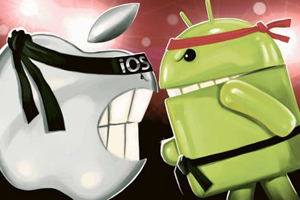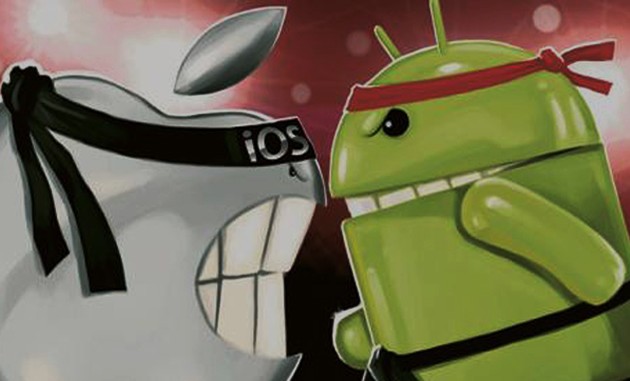 For the first time ever, Apple has pushed Android out of first place to grab the lead in the US smartphone market, going from just over a third of the market a year ago to over half of the market today. Android, meanwhile, has taken a hit in the US, but remains in the lead and growing in most other countries.
For the first time ever, Apple has pushed Android out of first place to grab the lead in the US smartphone market, going from just over a third of the market a year ago to over half of the market today. Android, meanwhile, has taken a hit in the US, but remains in the lead and growing in most other countries.
Thanks largely to the iPhone 5, Apple has achieved its highest ever smartphone market share in the US with 53.3% in the 12 weeks up to the end of November, according to a new report by UK-based analyst firm Kantar Worldpanel ComTech. That’s up from just 35.8% a year ago. Android lost nearly 11 percent to fall to about 42 percent of the US market.
There’s still hope for Android in the US, however. With the continued rise of top-end Android devices, iPhone sales in the US could face significant challenges if Apple does not make radical changes to its ageing iOS user interface, which hasn’t changed significantly since the iPhone was introduced in 2007. Apple could be forced to compromise the high margin associated with its iPhone in order to maintain volume share. According to US-based research firm Informa, US sales of the iPhone will decline to 34 million units in 2013, down from 35.5 million in 2012.
Informa expects Microsoft to slightly improve its market share in the US in 2013 to 6.5%, as both Nokia and HTC strengthen their Windows Phone marketing strategies and device portfolios, and tighten their partnerships with operators in the region.

US smartphone share by OS
Source: Kantar Worldpanel ComTech
Meanwhile in Europe, Android retains the highest share with 61% of the market, up from 51.8% a year ago, according to Kantar Worldpanel ComTech. Samsung continues to hold the number one smartphone manufacturer spot across Europe’s big five countries (England, France, Spain, Italy and Germany), with 44.3% share in the latest 12 weeks. Apple takes second place with 25.3% share while HTC, Sony and Nokia shares remain close in the chase for third position.
Among all types of mobile phones sold worldwide including non-smartphones, Samsung is now number one. The Korean company recently overthrew Nokia for the title of global mobile phone king, ending Nokia’s 14-year reign.
“Although Windows Phone sales in the US remain subdued, Nokia is managing to claw back some of its share in Great Britain through keenly priced Lumia 800 and 610 prepay deals,” says Kantar’s global consumer insight director Dominic Sunnebo. However, Sunnebo says that Nokia continues to find it tough to attract younger consumers in Great Britain. “With the Nokia Lumia 920 being one of the few handsets available on EE 4G, new tariffs may help to change this by attracting early adopters in the coming months.”
Smartphone percentage penetration in Great Britain hit 60% in the latest period, with 83% of all mobile phone sales over the past 12 weeks being smartphones, according to Kantar.
In the emerging smartphone market of India, Android phone ownership has grown rapidly– from 42% one year ago to over 56% today. Older platforms Symbian and Blackberry together still account for about 40% of India’s market, and although iOS and Windows Phone each claim less than a tenth of that number, they have strong growth potential if they can appeal to budget-strapped buyers.
In China — now the world’s largest mobile phone market — Kantar estimates that Android now holds a 70% share, bolstered by a wide range of devices and price options. Unsurprisingly, the iPhone is more popular among China’s city dwellers. Windows Phone is still struggling, but should receive a modest boost from the recent carrier deals by Microsoft and Nokia.
Almost a third of all Android devices sold in 2012 were sold in China, while the US is the second-largest market for Android with an 11% share, according Informa. Around 786 million smartphones were sold in 2012, including the devices powered by non-certified variants of Android that are proliferating in China, says Informa. This is 45% more than the total number of smartphones sold in 2011.
“China is by far the fastest-growing smartphone market with a year-on-year growth of 85% in 2012 and this growth is being driven by the explosive demand for Android phones,” says Malik Saadi, principal analyst with Informa Telecoms & Media. “Sales in China of Android devices exceeded 50 percent penetration in the first half of 2012.”
Of the other major platforms, Apple iPhone and Microsoft’s Windows Phone hold minority shares of China’s total handset sales, around 5% and 1%, respectively, in 2012, according to Informa’s Saadi. “However, thanks to Nokia’s partnership with China Mobile, Windows Phone is expected to improve its share in 2013 to 2% while iPhone is expected to lose market share slightly if Apple does not manage to create a TD-LTE variant for the Chinese market,” he says.
“Looking forward, Android is expected to continue gaining market share globally and, by 2015, one in every two handsets sold worldwide will be powered by it,” predicts Saadi. “However after 2016, Android’s market share could potentially peak – or even decline – owing to a more aggressive penetration of the alternative OSs, most notably Windows Phone.”





